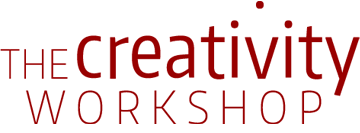Research shows that everybody is creative
In school, those who can write a good story or draw beautiful pictures are considered the special ones who are creative. But research shows that all people are creative.
In fact, creativity is one of the most important characteristics of being human. It is one of the main traits that make us successful as individuals and as a species.
Our workshops don’t merely talk about being creative—we spend our class time actively getting people to jump in and do creative work. We have found in our 25 years of teaching The Creativity Workshop that if we let our hand move faster than our brain, the hurdles to creativity disappear.
The astonishing thing is how easy it is with the right techniques to get people who think they have no creativity at all to do very innovative and imaginative work.
An ideal environment for teaching creativity includes exercises and techniques that are supportive, playful, surprising, and value process over product.
In case you have doubts about your own creativity there are scientific studies to prove it. American neurologist Alice Flaherty in her book The Midnight Disease, talks about the neural basis of creativity:
“A creative idea will be defined simply as one that is both novel and useful (or influential) in a particular social setting.”
Flaherty says that this applies to business, IT, science and math as much as it does to what we typically think of as “creative” fields, such as fiction writing, art or theatre.
Our brain and creativity
When we are doing something creatively what is actually active in our brain? Researchers Siyuan Liu and Allen Braun did research on this topic by tracking the brain activity of freestyle rappers.
It turns out that the parts of the brain that we use in ‘business as usual’ thinking are totally switched off when we are being creative, whereas other parts of our mind that we do not use everyday are quite active.
The medial prefrontal cortex showed increased activity during improvisation and lower activity in the dorsolateral prefrontal cortex.
Braun found that during creative expression, ‘executive functions’ take a back seat and more uncensored processes and de-focused attention happen.
George Land’s Creativity Test
George Land conducted a research study in 1968. What the test shows is that non-creative behavior is learned.
Land did a creativity test on children in the age group 3 to 5. This was the same test he conducted to select scientists and innovative engineers for NASA. He tested the same children at 10 years of age, and again at 15 years of age. The results were shocking.
While the creativity in 5 year olds was 98%, it went down to 30% when they reached the age of 10. And it was just 12% when they were tested as 15 year olders.
When the same test was given to 280,000 adults, the creativity was just 2%.
So why aren’t adults as creative as children?
Rules and regulations kill creativity. Our school systems typically denigrate imagination, day dreaming, and imperfection—all attributes that great minds say were key to their most revolutionary ideas. Educational systems all too often teach us not to think differently, but how to follow instructions and obey the status quo.
Creativity in education
The world is changing so rapidly now that just learning a specific skill set and following it exactly won’t get us very far. What prepares students for life beyond the classroom is learning how to be more creative, which includes flexibility in perception and execution of tasks.
Schools have started acknowledging the importance of creativity in classrooms. Courses in creativity are now provided by academia because it is now common knowledge that only creativity can help students succeed in the 21st century.
Creativity is no longer relegated in the classroom to subjects like English, art, or music. Teachers and professors are beginning to emphasize creativity in the sciences, as well.
Why we need creative educators
Sir Ken Robinson, an international advisor on education, once interviewed Hans Zimmer, the Oscar winning German composer. Zimmer apparently was an unruly child at school. He was thrown out from 8 schools.
When his parents took him to the ninth, the head teacher figured out how to get Zimmer involved in education just by talking to him. The head teacher organized for him to study music because Zimmer said he liked music. This led to his successful career.
Not just Zimmer’s music but the teacher and her teaching method are also creative. This again is proof of the importance of creativity in educators. Zimmer was lucky as the head teacher was creative in her teaching methods.
But in today’s greatly synchronized teaching environment there is little scope for creativity.
During a recent experiment, a creative writing task was given to science and arts students. To everyone’s surprise, the science students performed much better than arts students. The experiment showed the value of creative thought for scientists in the workplace. What makes their organizations excel is the creativity and innovation of these scientists.
Creativity in all of its forms should be embraced by educators if they want to nurture happy, well balanced students. The right kind of thinkers for future generations can be cultivated only through this method.
“The principle goal of education should be to create people who are capable of doing new things, not simply of repeating what other generations have done-men who are creative, inventive, and discoverers.” – Jean Piaget
Help students embrace this creativity is what educators should aim for. Let students give wings to the imagination without the fear of failure.
“It is the supreme art of the teacher to awaken joy in creative expression and knowledge.” – Albert Einstein
Teachers should become creative themselves if they want to instill creativity in their students, schools, and fellow educators.
Creativity – a crucial skill for professionals
Creativity is no longer just seen as what artists and musicians process. It’s a crucial skill for professionals in all fields.
The “20% rule” is practiced by most of the biggest and successful businesses in the world. This means that they are encouraging their employees to set aside 20% of their work time to exploring new ideas and thinking creatively.
In the modern business world creativity is valued as the most important business skill, says a recent survey.
For organizations the world over creativity and innovation are the number 1 strategic priorities.
The annual strategy survey by the Boston Consulting Group shows innovation and creativity as the top ranked tactical imperatives.
Creativity is part of all our day jobs
Many researchers would agree that in order to solve problems and exploit opportunities you have to think creatively in order to find useful and original ideas. According to a NESTA Everyday Innovation survey, creativity is an integral part of modern work. This is true not just for arch-strategists or chief executives, but for all of us.
In a new research by Adobe that surveyed college-educated professionals, it was clear that creative thought ought to have a more elevated precedence in the teaching curriculum and inn teacher professional development.
The U.S. study, Creativity and Education: Why it Matters, proves that to succeed in any career you need to be creative or you become obsolete. It also emphasized that while creativity is innate, it can be enhanced and developed as a learned skill.
Can Creativity be Taught?
Yes, creativity skills can be learned. You need an interest in the creative process, the desire to explore and a spirit of curiosity.
Several studies have been conducted on the effectiveness of creative training. These studies show that well-designed creativity training programs typically improve creative performance in students, teachers and working professionals in all fields.
How creativity courses can improve creativity
There are several courses that will help adults — educators, artists, musicians, authors, scientists, business people, IT, advertising and marketing professionals, as well as doctors and lawyers— improve their creativity through creative writing, photography, collage, storytelling, free-form drawing, guided visualizations and mindfulness.
What are the factors that contribute to the effectiveness of these training programs? Studies on these programs show that successful programs focus on development of cognitive skills using realistic exercises that allow participants to ask and re-ask questions in a variety of ways.
The most successful programs helped participants fight incapacitating self-criticism, perfectionism, and the fear of failure that lead to creative blocks.
These workshops are taught in a nurturing, playful, non-competitive environment where focus and freedom go hand in hand. Rather than focusing simply on a specific creative product, such workshops focus on the creative process, which can then be applied to developing many products, no matter how different they are. Effective creativity training and workshops emphasize that creativity is a way of living and leads to pleasure in life-long learning.
Developing creativity through play
The basic components of the creative process are involved in play. It generates new experimentation, possibilities, and exploration of unlimited fantasy and reality. For the development of a healthy personality, play is crucial.
A child is calm and satisfied after a good session of play. The child often experiences deep distress if play is disrupted. The child experiences frustrations if the environment is too strict and he feels tortured. Such a child may begin to torture others.
In the book Human Development: An Introduction to the Psychodynamics of Growth, Maturity and Ageing, authors Eric Rayner, James Rose, Angela Joyce, Christopher Clulow, and Mary Twyman, say that these cruel games can carry on into adult life, in criminal behaviour or empire building. For meeting curriculum standards play is often prevented and this could have a harmful and negative impact on children’s personality formation.
An adult who has lost his/her creative spark can be taught how to be creative through play. Through a series of experiments they retrieve the child’s sense of wonder in adults. Participants in a creativity training program are taught how to fit into place in the process of creativity, and increase self-confidence in their creativity through play.
Tap into inborn creativity
Creativity is required to succeed in life. People are born creative, and given the right environment and with the right creative tools and training everyone can tap into this innate talent.





